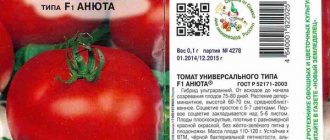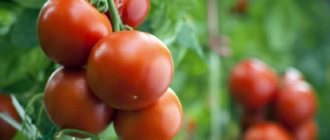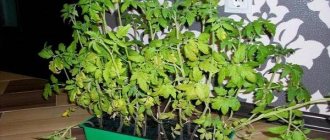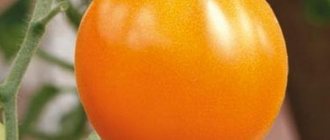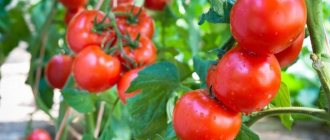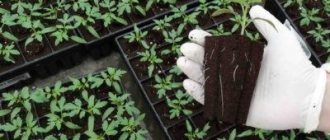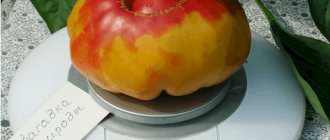Lyudmila Kozasova growing tomatoes
At first, Lyudmila bought seedlings at the market, because she did not have the strength to tinker with the seeds, but over time she plunged into gardening.
“I can’t sit idle, so I started growing peppers, eggplants and tomatoes. That’s the kind of person I am: everything I undertake, I either do well, or I don’t do it at all.” - this is the collector’s answer.
– What do you want to achieve in your greenhouse?
- Much of this has already been done. Now there are about 500 varieties of tomatoes in my collection. It’s clear that I didn’t collect them in one day. They sent me varieties from the USA, Germany, Sweden, and Holland. Foreign tomatoes perform differently in our climate. In Latvia, you generally have to make a lot of effort to get a harvest, and every spring is a challenge. Let's start with the fact that the tomato is a very capricious berry; it does not like our fogs and morning colds. In the spring, if you do not have time to close the greenhouse, the seedlings turn black and die. In addition, seed germination varies, and some seeds are sold individually. It also happens that tomato varieties do not correspond to the information on the labels. But when you overcome all these difficulties and grow a certain variety with good yields, it’s such a pleasure!
By leaps and bounds!
– Over the years, you have probably accumulated a lot of knowledge about how to properly grow tomatoes. Share your secrets with us?
– I don’t use chemicals in the garden. I fertilize with horse and cow manure and make my own balm for tomatoes. To do this, I take a 200-liter barrel, fill two-thirds with fresh nettles or any other herb, add two kilograms of yeast, half a bucket of ash. I fill it with water and cover it for two weeks. After watering with this balm, everything grows by leaps and bounds! For a greenhouse with an area of 30–40 square meters, I need two such barrels. I water three times a season and finish before the tomatoes begin to ripen. I also fight late blight with natural preparations; I spray the plantings with boron, iodine and manganese.
– This year, gardeners are complaining that tomatoes do not want to gain color.
– To speed up the ripening of tomatoes, I water them with iodine. This kind of watering is needed if the tomatoes have already reached their full weight, but due to the weather they cannot ripen or take on color. Then I add 30–40 drops of iodine to a bucket of water and pour a liter under each bush.
Are you afraid of salt? In vain!
– Do you have other amazing recipes in stock?
- Certainly! For example, another such recipe is watering with a weak saline solution (1-2 tablespoons per bucket of water). This solution is used to water beets and tomatoes so that the fruit has a good taste. Watering is carried out once, before ripening, when the tomatoes have gained weight. Again, a liter is poured under each bush. Sometimes neighbors are surprised: “Why are your tomatoes so sweet, but ours are tasteless?”, but they are afraid to use salt irrigation themselves - they say, how can it be? But you need a very weak solution, which will not harm the tomatoes in any way.
– Where did you learn such wisdom?
– I still continue to learn and test new methods. I draw conclusions from personal experience: if the method is good, I recommend it to others. For example, gardeners often ask how to prepare the soil in a greenhouse for planting seedlings. After harvesting tomatoes, I water the greenhouse soil with a thick solution of manganese or Baikal fertilizer. I wash glass walls with regular washing powder, which kills all the nastiness. Then I plant the greenhouses with white mustard, it disinfects the soil. When the mustard grows 150–20 centimeters tall, I dig it up and sow the greenhouse with rye, which can grow until spring. This is the perfect option! Rye leaves the soil with a full range of microelements.
LiveInternetLiveInternet
Quote from Lyubasha_Bodya's message
Read in full In your quotation book or community!
ALL THE SECRETS OF THE COLLECTOR OF 1300 VARIETIES OF TOMATOES BY LYUDMILA KOZASOVA:
At first, Lyudmila bought seedlings at the market because she did not have the strength to tinker with the seeds, but over time she plunged into gardening.
“I can’t sit idle, so I started growing peppers, eggplants and tomatoes. That’s the kind of person I am: everything I undertake, I either do well, or I don’t do it at all.” - this is the collector’s answer.
Recommendations and advice from L. Kodzasova:
PLANTING AND CARE OF SEEDLINGS
It is best to sow tomatoes in boxes with a turf-humus mixture.
You can add some mineral fertilizers. Place the boxes in the warmest room and water the soil before planting the seeds. Divide the entire space into beds, alternating them every five centimeters. Then place the seeds in boxes at a distance of one centimeter. Cover the boxes with plastic wrap and ensure the room temperature is around 25 degrees Celsius. Sprouts will appear within 7-10 days. Now the film can be removed and the boxes can be placed in the most illuminated place. Tomato seedlings should be watered sparingly. They take morning watering very well, especially on sunny days.
Transplantation of seedlings is necessary two weeks after the emergence of sunrise. You should try to transplant them into separate pots with a diameter of 12 cm and try not to damage the root system when transplanting.
Water with warm water and cover from the sun for several days. When growing tomato seedlings, it is very important to provide the plant with plenty of light and space. If you can create such conditions at home, you can sow seeds even in January. But here it is important to have a well-heated greenhouse with enough light to transplant seedlings from the windowsill in time.
WHAT IS PICKING
Strictly speaking, picking, or picking, is the removal of the final part of the tap root of seedlings in order to stimulate branching of the root system. Traditionally, this word refers to any planting of plants from common dishes into individual containers. For picking, a pointed peg is used (in French - pique). Rejection of weak, thin or yellowed seedlings is mandatory, therefore, when picking plants, immediately discard those that seem low-grade to you. In order not to damage the root system during picking, you must use a special spatula, pencil, or stick. Before picking, the plants must be watered generously and left for 20-30 minutes so that the soil becomes softer and more pliable, then thin stems and roots will separate more easily and freely.
How to pick seedlings:
- separate the seedling with a spatula, holding it by the cotyledon leaves; it is not recommended to hold it by the plant’s leg, since the fragile stem easily breaks when touched by hands;
- remove the plant from the soil, carefully tearing off the central rhizome (it is better to do this with nail scissors), leaving only 2/3 of the entire rhizome;
— make a small depression in the pot where the plant will be transplanted, deepen it to the growth point (small compaction above the rhizome) or 0.5 cm deeper;
- sprinkle the seedling with soil, lightly pressing the layer;
- pour moderately with plain water at room temperature and place in a darkened room for 2-3 days.
HELPERS IN THE GARDEN
green stuff in my garden apron pocket. If you have to cut a thin branch from a bush, it is easier to lubricate the cut with brilliant green than to run for garden spray. I use brilliant green to lubricate the places where the cuts and trims are made on the root tubers and bulbs. And if the pumpkin skin is injured, you also need brilliant green, the wound will heal quickly and there will be no problems with storage.
It is clear that potassium permanganate is always needed; it is the most affordable and convenient disinfectant for seeds and bulbs. I spray strawberries with a solution of potassium permanganate (2 teaspoons per 10 liters of water) prophylactically after flowering against gray rot. I bathe potatoes in a dark pink solution before planting to repel wireworms, and seed potatoes before storing them.
Boric acid is very necessary in dacha farming. If the fruits of zucchini or zucchini rot, if the tomatoes in the greenhouse are stressed from the heat, if the fruits of peppers and eggplants do not set, if there are few ovaries on cucumbers, make a solution of boric acid and spray the plants. The recipe is as follows: thoroughly mix 2 g of boric acid in 500 ml of hot water and add up to 10 liters of water heated in the sun.
glucose and vitamin B1 to fertilizing waterings of especially valuable indoor and potted plants. For 5 liters you need 5 ml of glucose and 1 ml of vitamin B1. 5-6 waterings at intervals of 2 weeks and your plants will be rewarded with powerful growth and abundant flowering.
Laundry soap (“Soviet” 72%) is also needed to add to infusions and decoctions for sticking. I water green vegetables and flower seedlings with a soap solution if there are a lot of aphids on them (150 g per 10 liters of water). I also use it to wash flower pots and all kinds of tools. Moreover, such soapy water can be safely used for watering trees and shrubs.
Source: milana89.wixsite.com
– What do you want to achieve in your greenhouse?
- Much of this has already been done. Now there are about 500 varieties of tomatoes in my collection. It’s clear that I didn’t collect them in one day. They sent me varieties from the USA, Germany, Sweden, and Holland. Foreign tomatoes perform differently in our climate. In Latvia, you generally have to make a lot of effort to get a harvest, and every spring is a challenge. Let's start with the fact that the tomato is a very capricious berry; it does not like our fogs and morning colds. In the spring, if you do not have time to close the greenhouse, the seedlings turn black and die. In addition, seed germination varies, and some seeds are sold individually. It also happens that tomato varieties do not correspond to the information on the labels. But when you overcome all these difficulties and grow a certain variety with good yields, it’s such a pleasure!
By leaps and bounds!
– Over the years, you have probably accumulated a lot of knowledge about how to properly grow tomatoes. Share your secrets with us?
– I don’t use chemicals in the garden. I fertilize with horse and cow manure and make my own balm for tomatoes. To do this, I take a 200-liter barrel, fill two-thirds with fresh nettles or any other herb, add two kilograms of yeast, half a bucket of ash. I fill it with water and cover it for two weeks. After watering with this balm, everything grows by leaps and bounds! For a greenhouse with an area of 30–40 square meters, I need two such barrels. I water three times a season and finish before the tomatoes begin to ripen. I also fight late blight with natural preparations; I spray the plantings with boron, iodine and manganese.
– This year, gardeners are complaining that tomatoes do not want to gain color...
– To speed up the ripening of tomatoes, I water them with iodine. This kind of watering is needed if the tomatoes have already reached their full weight, but due to the weather they cannot ripen or take on color. Then I add 30–40 drops of iodine to a bucket of water and pour a liter under each bush.
Are you afraid of salt? In vain!
– Do you have other amazing recipes in stock?
- Certainly! For example, another such recipe is watering with a weak saline solution (1-2 tablespoons per bucket of water). This solution is used to water beets and tomatoes so that the fruit has a good taste. Watering is carried out once, before ripening, when the tomatoes have gained weight. Again, a liter is poured under each bush. Sometimes neighbors are surprised: “Why are your tomatoes so sweet, but ours are tasteless?”, but they are afraid to use salt irrigation themselves - they say, how can it be? But you need a very weak solution, which will not harm the tomatoes in any way.
– Where did you learn such wisdom?
– I still continue to learn and test new methods. I draw conclusions from personal experience: if the method is good, I recommend it to others. For example, gardeners often ask how to prepare the soil in a greenhouse for planting seedlings. After harvesting tomatoes, I water the greenhouse soil with a thick solution of manganese or Baikal fertilizer. I wash glass walls with regular washing powder, which kills all the nastiness. Then I plant the greenhouses with white mustard, it disinfects the soil. When the mustard grows 150–20 centimeters tall, I dig it up and sow the greenhouse with rye, which can grow until spring. This is the perfect option! Rye leaves the soil with a full range of microelements.
In the spring, I dig up the soil with rye and prepare holes for seedlings. In each hole I put half a bucket of rotted horse manure, a tablespoon of fish meal, a tablespoon of superphosphate and half a glass of ash. I water it with a pink solution of manganese for disinfection and begin planting. My husband and grandson help me, they dig up the soil for me, and I do the rest myself.
– Is it difficult to grow seedlings from seeds?
– Yes, it takes effort. But if you collect the seeds correctly and process them, you will get great pleasure watching the greenery appear. Many market traders water seedlings with saltpeter to achieve beautiful greenery and strong trunks. I don’t use chemicals, I water it with “Ideal” - this is a liquid extract from earthworms. I buy soil in construction stores, but you also need to choose it wisely; sometimes you even come across soil with fungus.
At work - from the first days of January
– When should you start gardening?
– I plant peppers and eggplants as seedlings in early January, and tomatoes from mid-February to mid-March. This is a very labor-intensive process. All seeds need to be checked, processed, and their watering monitored. Once you water the seedlings, a “black leg” will form and the tomatoes will die. The most difficult procedure is picking. But the work pays off! Sometimes the seedlings turn out thin, but I plant them in a greenhouse, after 10 days I water them with Baikal - and soon my tomatoes will be unrecognizable! The most pleasant thing is when the flowers bloom on the bushes and the fruits begin to bloom before your eyes.
– Which countries’ varieties take root best?
– You know, all varieties take root with me, even overseas ones. Very good seeds are sent from Tyumen. A gardener I know sent me seeds of the Adonis variety and warned me that the bush can produce fruits weighing up to 350 grams. And I grew tomatoes weighing 950 grams! So “Adonis” liked it in Latvia.
– I see that you are always in contact with other tomato growers around the world.
– Yes, this is a necessary condition for a collector! For example, I have been communicating with members of the Latvian club Tomāts for a long time. I myself joined the club only recently, because I considered myself not experienced enough. Now that I have about 500 varieties, I finally feel worthy of membership in the organization.
“Pink Honey”, “Adonis”, “Bull’s Heart”...
– What was the largest tomato in your greenhouse?
– I managed to grow fruits weighing 1.5 kilograms. Such a harvest was produced by the “pink honey” bush. In general, the largest-fruited tomatoes come from varieties produced by Russian breeders.
– Tell me, is there such a thing in the world as fashion for tomatoes?
– Yes, for example, in Latvia they traditionally love “ox heart” tomatoes, although there are many similar and even more interesting varieties in the world. The same “Adonis” tomatoes could successfully replace “ox heart”, they have better taste and higher yield. But our people are conservative.
– What varieties of tomatoes should gardeners choose if they want to get the maximum yield?
– I advise you to pay attention to the new variety “Vova Putin”, the fruits of which reach a weight of 1.2 kilos. You can get about 40 kilograms of tomatoes from three bushes! In general, members of the Tomāts club have many interesting varieties, but ordinary gardeners find it difficult to get seeds of new varieties. Most people only have access to seeds from Holland or Poland.
Are there tires in stores?
– Tell me, are there new delicious varieties of tomatoes appearing on the market or in stores?
– No, they mainly sell hybrids there. They are good only if a person wants to crunch on a tomato instead of a cucumber. Have you ever seen tomatoes with juicy pulp and sugar in the store? One day I accidentally dropped a store-bought tomato and thought it would break into a cake. I picked it up - and there was not a crack on it! By comparison, my tomatoes melt in my hands.
– Where can I buy delicious tomatoes?
– In any store that sells seeds (they work well with QUALITY suppliers).
– This year you planted 120 varieties of tomatoes. Where do you send the excess?
– You won’t believe it, I have a lot of friends. Give everyone a tomato - and just make sure you get it yourself! In addition, I use a lot of varietal tomatoes for seeds.
Source: mklat.lv
TO BE CONTINUED - THERE WILL BE ADDITIONAL TIPS!!!
Your LYUBASHA BODIA
Add a comment Cancel reply
You must be logged in to post a comment.
Lyudmila Kodzasova is a well-known collector of rare and even exotic varieties of tomatoes in Latvia. Therefore, the most common question we are asked is: How to buy seeds from Lyudmila?
She became interested in growing tomatoes relatively recently - with the acquisition of a summer cottage. And although Lyudmila had never even imagined herself working in the garden beds before and was not a lover of agriculture, she has now tested more than 1,300 varieties in her greenhouses and has become a major collector.
Every year Lyudmila reads catalogs again and again, looks for new items, and no matter how hard she tries to restrain herself, she orders new varieties of tomatoes for her collection from America, Russia, Belarus and other countries. At the end of the season, the collector evaluates the variety and decides to keep it or not, to recommend it to customers or not... Therefore, there is no doubt that when buying varietal tomato seeds from Lyudmila, you will receive not only a tested variety with a recommendation, but also a little, and sometimes a lot , adapted to the natural conditions of Latvia.
Lyudmila herself prefers large-fruited indeterminate varieties. For example, she has a large collection of “hearts” - heart-shaped tomatoes. A tomato of the family variety Peach can weigh up to 1 kg with certain care.
Of course, Lyudmila takes care of the tomatoes in her greenhouses from morning to night. Gartering bushes and fruits, shaping the plant, regulating the number of ovaries are its mandatory agrotechnical techniques! And this is all in addition to spraying, watering, loosening, weeding...
In addition to large-fruited tomatoes, Lyudmila also loves different “multi-colored” varieties: green and white, striped and bicolor, tricolor and indigo... There is so much in her collection! Strange Thing of a Girl, Everett's Rusty Heart, Serendipity, Hairy Kate - for the average person this is a strange set of words, but for amateur tomato growers, treasured varieties of American and Canadian selection. And of course, they, and many others, are already in Lyudmila’s collection!
August 29th, 2016
Summer is now extremely wet, with large temperature changes. Many gardeners have had no luck with tomatoes. A severe outbreak of late blight hit the plantings. The harvest was in danger of being destroyed.
Lyudmila Zakharovna Saksina, a member of the Garden Art club, has her own method of growing tomatoes. Her tomatoes survived the current difficult summer well, and late blight did not affect them. She shared her secrets with us.
I would like to tell you, dear summer gardeners, how I grow heroic tomatoes. The technique has been tested.
Lyudmila Saksina: My tomatoes are not afraid of late blight
When growing garden crops, strictly follow the commandments of natural farming:
- Do not dig the ground unless absolutely necessary.
- Do not loosen the soil deeper than 5 cm.
- Beware of bare soil - cover it with organic matter, mulch, and sow green manure.
- Feed the living creatures in the soil, just like your animals.
- Maintain crop rotation.
- Do not violate the planting deadlines for our region.
- To protect against pests and diseases, use only biological products.
- Healthy soil - healthy plants - the foundation of the future harvest.

